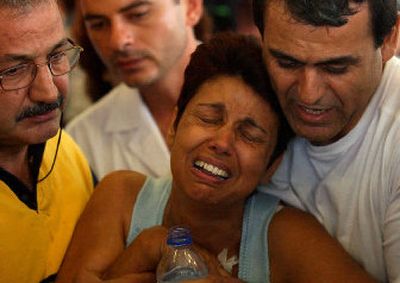Pilots pass out, dooming jet

GRAMMATIKO, Greece – Flying 34,000 feet above the Aegean Sea, the F-16 fighter-jet pilots peered into the cockpit of the Cypriot passenger plane they had been sent to save.
No one was at the controls. The co-pilot was slumped over in his seat. The captain was nowhere in sight. Oxygen masks dangled in the cabin.
The fighter-jet pilots flew by a second time and saw two people apparently trying to take control of the Boeing 737.
Forty minutes later, Helios Airways Flight ZU22 crashed into a mountainside near the ancient city of Marathon on Sunday, the plane breaking into pieces and bursting into flames, hurling bodies and debris across the scenic valley.
All 121 people on board, more than a third of them children, were killed in Greece’s deadliest plane disaster.
The cause appeared to be technical failure – resulting in high-altitude decompression and lack of oxygen – and not terrorism. A transport official said the 115 passengers and six-member crew may have been dead when the plane went down.
“We saw some fighter jets flying very low, and after a few minutes, we heard a very loud noise and saw pieces of the plane flying in the air,” said Spyros Papachristou, a Grammatiko resident who witnessed the airliner crash at 12:05 p.m.
Family members wept in anguish as they waited at the Athens, Greece, and Larnaca, Cyprus, airports. When news of the crash emerged at Larnaca, relatives swarmed the airline counters, shouting, “Murderers” and “You deserve lynching.”
A man whose cousin was a passenger told Greece’s Alpha television he received a cell-phone text message minutes before the crash. “He told me the pilots were unconscious. … He said, ‘Farewell, cousin, here we’re frozen,’ ” Sotiris Voutas said – indicating the plane was cold, a sign of decompression.
About a half-hour after takeoff at 9 a.m., the pilots reported air-conditioning problems to Cyprus air-traffic controllers. Within minutes, after entering Greek airspace over the Aegean, the plane lost all radio contact. The two Greek F-16 fighter jets were dispatched soon afterward.
Government spokesman Theodoros Roussopoulos described to reporters what the jet pilots had seen inside the cockpit. It was unclear whether the two people trying to take control were crew members or passengers.
The plane apparently was on automatic pilot when it crashed, Helios spokesman Marios Konstantinidis said in Cyprus.
“When a pilot has no communication with the control tower, the procedure dictates that other planes must accompany and help the plane land. Unfortunately, it appeared that the pilot already was dead as was, possibly, everyone else on the plane,” Cyprus Transport Minister Haris Thrasou said.
The head of the Greek airline safety committee, Akrivos Tsolakis, said the crash was the “worst accident we’ve ever had.” He said the plane’s black boxes had been recovered, containing data and voice recordings valuable for determining the cause of the crash.
“There apparently was a lack of oxygen, which is usually the case when the cabin is depressurized,” Tsolakis said.
The F-16 jets met the plane at 34,000 feet, the Greek air force said. At that altitude, the effects of depressurization are swift, said David Kaminski Morrow, of the British-based Air Transport Intelligence magazine.
“If the aircraft is at 30,000 feet, you don’t stay conscious for long, maybe 15 to 30 seconds,” he said. “But if you are down at 10,000 feet, you can breathe for a lot longer.”
The flight was to have continued to Prague, Czech Republic, after stopping in Athens.
This is the height of Europe’s summer travel season, when Mediterranean resorts such as Cyprus are packed with tourists. The area is likely to be particularly crowded because today is a national holiday in Greece and Cyprus.
There were 48 children aboard, mostly Greek Cypriots, Helios spokesman Giorgos Dimitriou said.
Greek state television quoted the Cyprus transport minister as saying the plane had had decompression problems in the past. However, Dimitriou said the plane had “no problems and was serviced just last week.”
On Cyprus, several callers to radio and television programs said they had experienced severe air-conditioning problems on Helios jets in recent months. Some said the cabin was freezing and the crew had provided blankets; others said it became unbearably hot.
Sudden loss of pressure was blamed for a crash in South Dakota in 1999 of a Learjet 35 carrying pro golfer Payne Stewart and four others. They became unconscious, and the jet went down after flying halfway across the country on autopilot.
In June 2000, a Boeing 737-200 of the Canadian carrier WestJet lost cabin pressure because pilots mistakenly shut down auxiliary power. The plane’s altitude reached 24,000 feet before the plane descended and pressurization became normal. None of the 118 passengers was injured.
At the Greek crash scene, more than 100 firefighters, backed by planes and helicopters dropping water, fought a brush fire caused by the crash. The plane was in at least three pieces: the tail, a bit of the cockpit and a piece of fuselage that witnesses said contained many bodies.
Fire department rescue vehicles carried body bags up the steep slopes of the charred valley to a fleet of ambulances. None of the bodies had masks on their faces, the fire department said. Black-robed Greek Orthodox priests were on hand.
Relatives from Cyprus were to be taken to a reception center near the Athens airport, but the remains of many victims were charred beyond identification. The Cyprus transport minister said DNA tests would be necessary to identify them.
Greek Prime Minister Costas Caramanlis canceled a holiday on the Aegean island of Tinos to return to Athens. The Cypriot president also canceled a vacation.
Helios Airways, Cyprus’ first private airline, was founded in 1999. It operates a fleet of Boeing 737s to cities including London; Athens; Sofia, Bulgaria; Dublin, Ireland; and Strasbourg, France.